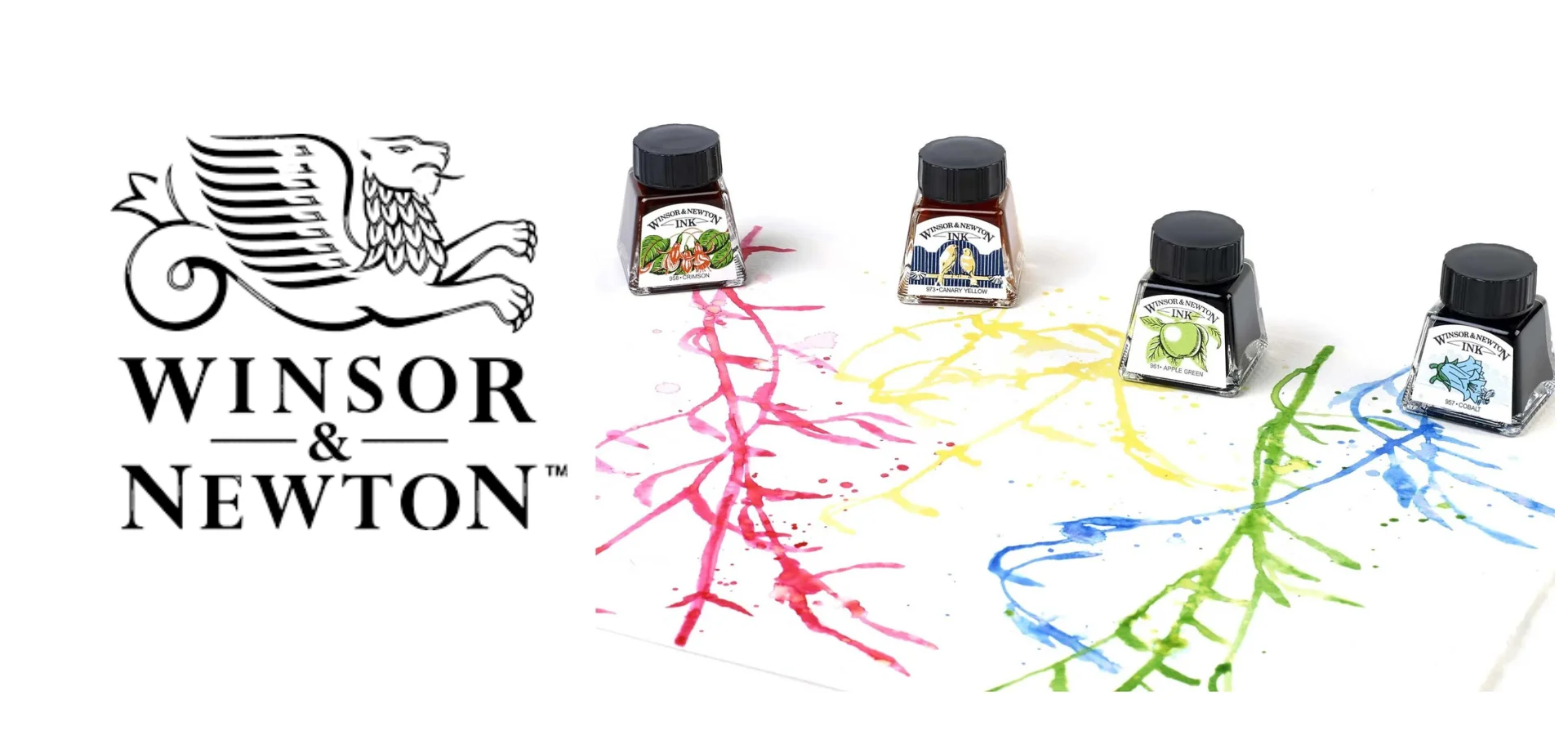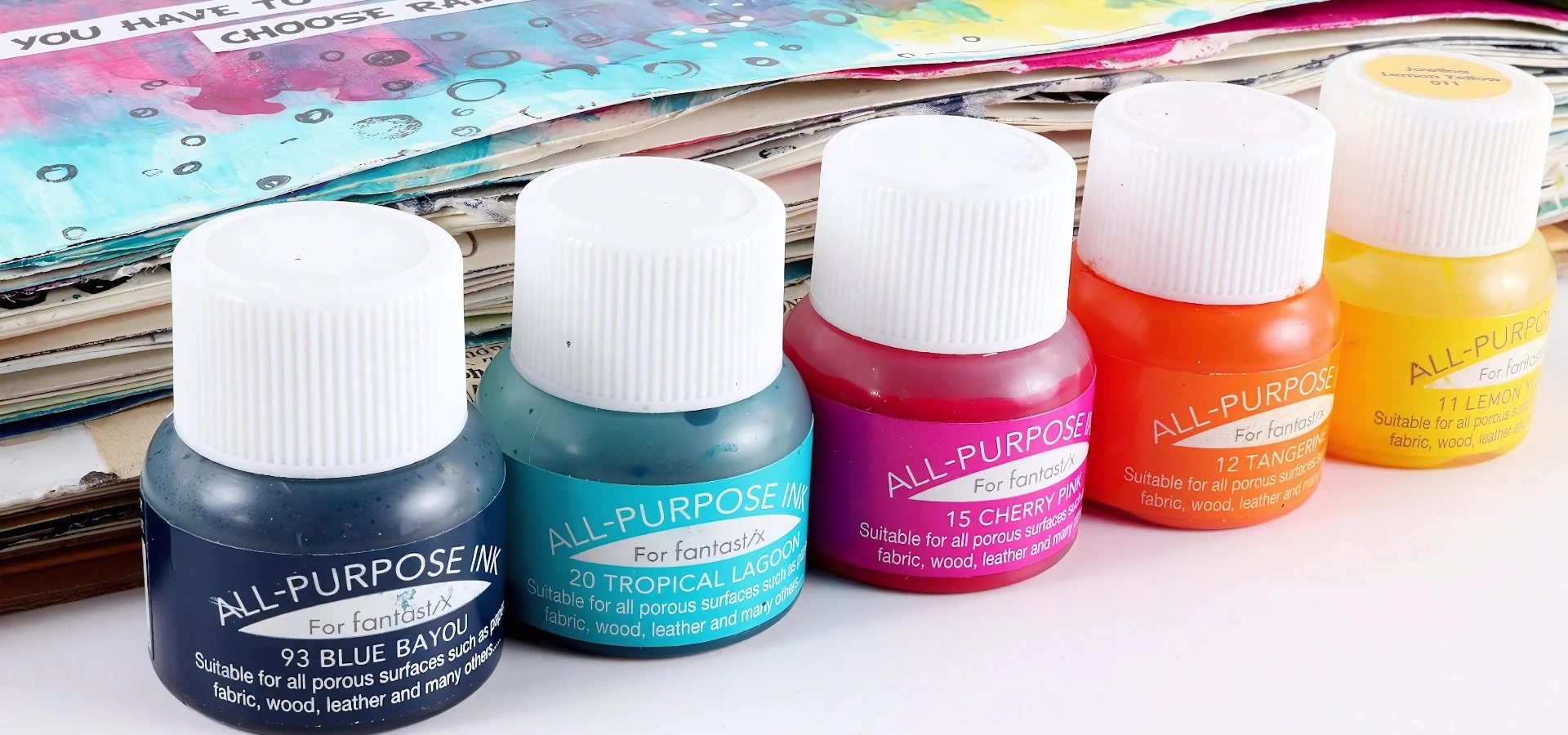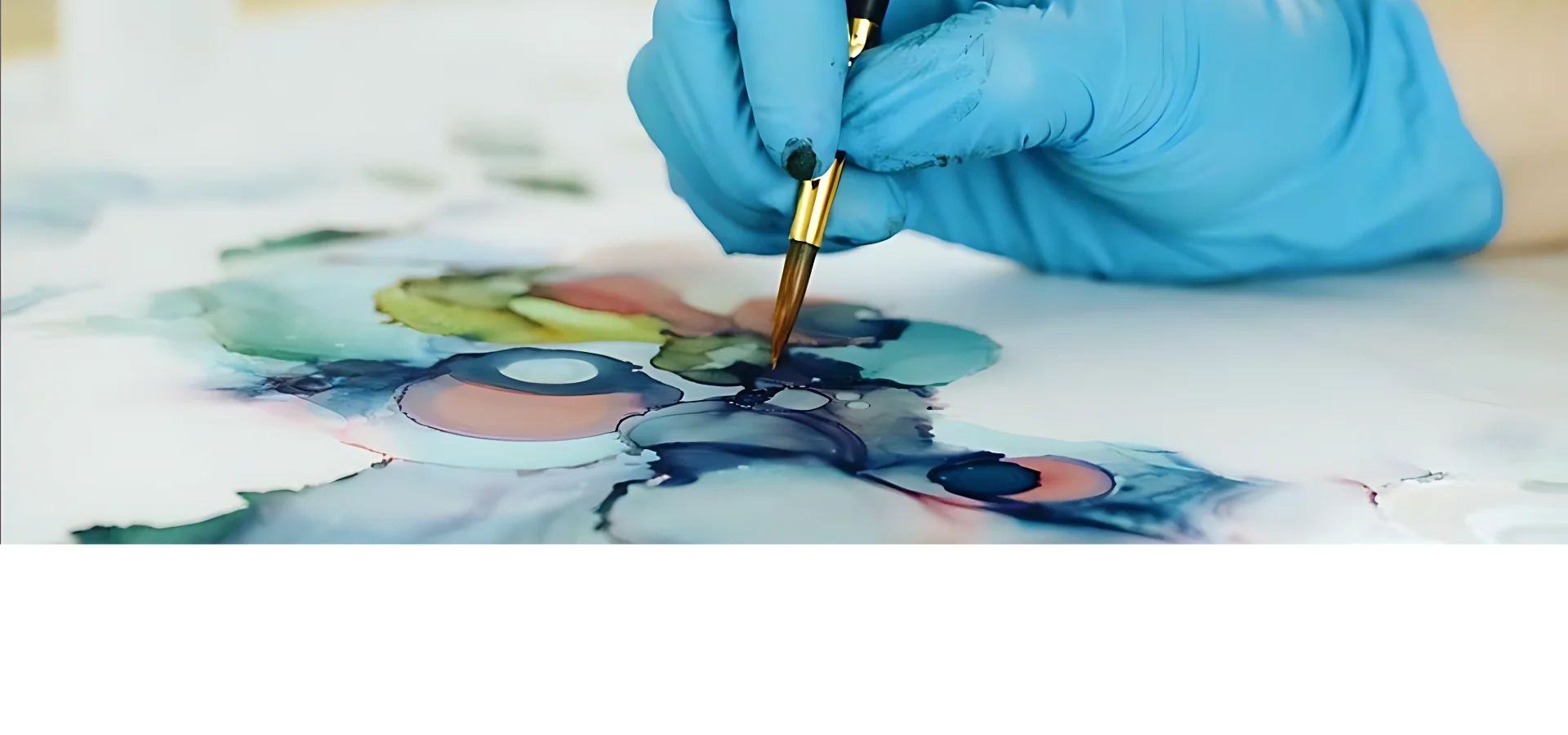
Alcohol Ink Surfaces
Ah, the marvellous world of alcohol ink! Dive into this colourful chaos and discover the perfect surface for your inky masterpieces. Choosing the right canvas for your colourful concoctions can make all the difference. Here, we’ll unravel the intricacies of alcohol ink surfaces.
Introduction to Alcohol Ink Surfaces
When it comes to alcohol ink art, not all surfaces are created equal. The choice of substrate can influence how your ink flows, blends, and ultimately, how your masterpiece turns out. Traditional papers and canvases might be your go-to. But with alcohol inks, non-porous surfaces are the star of the show.
Types of Surfaces:
- Yupo Paper: Synthetic, polypropylene paper known for its non-porous, smooth surface (Kersting Designs).
- Glass: Allows inks to flow freely and blend effortlessly.
- Ceramic: Offers a sleek surface for vibrant and flowing designs.
Surface behaviour is pivotal in alcohol ink projects:
- Non-porous Surfaces: Inks do not absorb but sit on top, creating brilliant colours and intricate textures.
- Porous Surfaces: Inks are absorbed, often leading to dull colours and less vibrant artwork.
| Surface Type | Ink Absorption | Colour Vibrancy | Surface Smoothness |
|---|---|---|---|
| Yupo Paper | Non-absorbent | Highly vibrant | Smooth |
| Glass | Non-absorbent | Highly vibrant | Very smooth |
| Ceramic | Non-absorbent | Highly vibrant | Smooth |
| Traditional Canvas | Absorbent | Dull | Textured |
Importance of Choosing the Right Surface
Choosing the right surface isn’t just about the vibrancy of the colours; it’s also about how well your creative process flows. Imagine trying to blend on a paper that soaks up every drop of your precious ink. Nightmare!
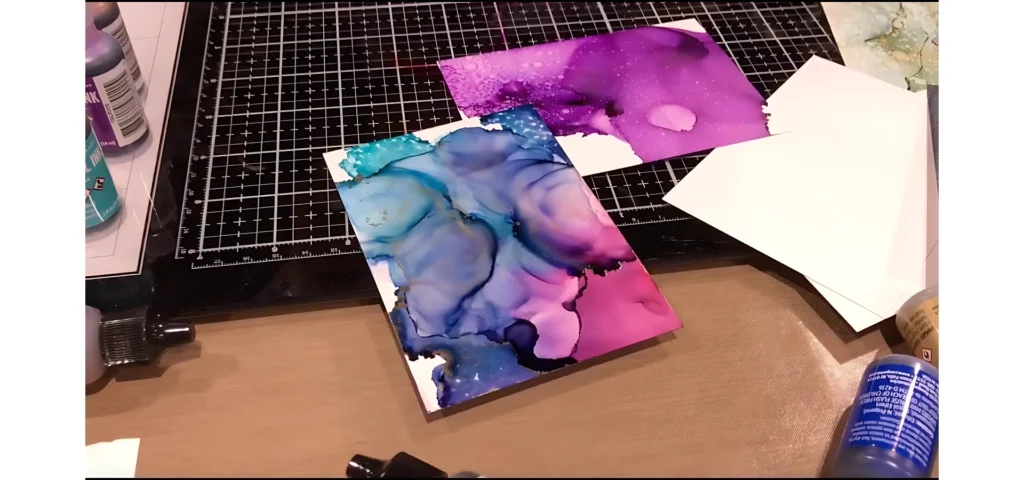
Vibrancy and Flow
Yupo paper, with its smooth, non-porous surface, lets your inks dance and intermingle to create vibrant hues and stunning patterns. It’s no wonder Yupo paper is a favourite among alcohol ink artists (Kersting Designs). The ink stays on the surface, allowing for endless blending possibilities and intense colours.
Technique Compatibility
Whether you’re into the ethereal, soft blends or the bold, geometric shapes, your surface choice affects technique execution. For example:
- Blending: Achieve those dreamy fades with a blow tool or isopropyl alcohol.
- Detail Work: Perfect intricate designs without affecting already satisfactory parts (ArtResin).
Durability and Finish
Applying a resin coat to your Yupo paper masterpiece can enhance the colours, bring out fine details, and provide UV protection. This seal protects your artwork and ensures it remains as radiant as the day you created it (ArtResin).
By experimenting with different surfaces, you can discover the medium that best suits your artistic style and unleash the full potential of your alcohol ink projects. Let your creativity run wild, and remember, the right surface can transform a good painting into a spectacular one.
Yupo Paper for Alcohol Inks
When it comes to creating dazzling artworks with alcohol inks, Yupo paper is a favourite choice among artists. Let’s take a closer look at what makes this paper the Picasso of synthetic papers.
Characteristics of Yupo Paper
Firstly, Yupo paper is a synthetic paper made from polypropylene pellets. Picture a mix of bright white and completely non-porous, and you get a canvas that’s perfect for those inky adventures (Your Decorative Painting Resource). Here are some standout traits:
- Material: Made from 100% polypropylene, which means no trees were harmed in the making of your artwork!
- Surface: Non-porous and smooth, making it an ideal playground for inks to flow freely and blend seamlessly. Stubborn stains? Not here, thanks to its stain-resistant property.
- Durable: Waterproof, acid-free, and resistant to buckling—the Bruce Willis of papers! It’s durable enough to handle heavy ink usage without falling apart.
- Appearance: Boasts an exceptional whiteness, making your colours pop like fireworks on New Year’s Eve.
| Property | Description |
|---|---|
| Material | 100% Polypropylene |
| Surface | Non-porous, smooth |
| Durability | Waterproof, acid-free, stain-resistant |
| Appearance | Bright white, neutral pH, archival |
Moreover, Yupo paper has been gracing the art world since the late ’90s, gaining a stellar reputation for its unique attributes (Doodlewash).
Why Yupo Paper is Ideal for Alcohol Inks
You might ask, “Why is Yupo paper such a hit with alcohol ink artists?” Well, here’s the lowdown:
Vibrant Colours and Interesting Textures
The non-absorbent nature of Yupo paper means that the ink doesn’t just sink in and get lost. Instead, it stays on the surface, allowing for vibrant colours to shine through and creating interesting textures with minimal effort (Kersting Designs).
Ease of Blending and Control
Since the ink remains on the surface, blending becomes a joyful escapade. Artists can manipulate the ink to achieve different effects using various tools like brushes, air blowers, or straws. This allows for more creative control and precision.
Durability
Forget about tears and warps; Yupo paper is designed to withstand the ravages of creative genius. Its waterproof and stain-resistant properties mean that your masterpiece will stay pristine, no matter how wild your inking gets.
To enhance your inking experience on Yupo paper, it’s advisable to tape down the edges to minimize warping and use blending solutions sparingly to prevent bleeding (My Art Shop).
For artists looking for the ultimate surface for their alcohol ink projects, Yupo paper truly stands out. Its unique characteristics make it a staple in the world of creative arts, allowing for endless experimentation and boundless creativity. Curious about alternative surfaces?
Best Practices for Alcohol Ink Art
Creating stunning artwork with alcohol inks on surfaces like Yupo paper requires a mix of techniques, a sprinkle of creativity, and a dash of knowledge. This section spotlights the best practices for achieving beautiful results, focusing on blending techniques and how to correct those pesky mistakes when they inevitably happen.
Blending Techniques
Blending is one of the most crucial aspects of working with alcohol inks. Understanding how to manipulate the inks can lead to a beautifully seamless piece or, in other instances, a chaotic mess. So, what are your trusty tools for blending?
- Isopropyl Alcohol: The unsung hero of blending solutions. When added to alcohol ink, it increases fluidity and helps the ink spread more evenly. The best part? It also retains the shine and avoids pigment break (Piece Of My Art).
- Blending Solution: Produces slightly different results compared to isopropyl alcohol. It blends colors without pushing the ink to spread as much and has a different drying time, offering artists more control over the outcome (ArtResin).
Each medium provides slightly different results:
| Medium | Effect | Use Case |
|---|---|---|
| Isopropyl Alcohol | Increases fluidity, spreads ink | Large, smooth blends |
| Blending Solution | Blends without spreading, longer drying | Detailed, controlled blends |
Blending techniques differ based on the effect desired. Do you want a soft, gradient-like transition between colors? Use a brush dipped in isopropyl alcohol and gently spread the colors. For more controlled blending, a bit of blending solution on a cotton swab or brush can work wonders. Always remember, protecting your masterpiece by sealing it with a resin coat assures longevity and vivid color.
Detail Work and Mistake Corrections
With alcohol inks, precision can be challenging but also crucial for adding those fine details that make your artwork pop. Fear not—the ability to correct and enhance details is here to make your life easier.
Detail Work
- Fine Brushes: Perfect for adding intricate details or splashes of accent colors that steal the show. Create faded edges with isopropyl alcohol and fan out colors to enhance the overall composition (ArtResin).
- Toothpicks or Sharp Tools: Great for scraping away small areas of ink to add highlights or restore lighter tones.
Mistake Corrections
Mistakes happen, even to the best of us. Here’s how to fix them without breaking into a sweat:
- Isopropyl Alcohol: Dip a cotton swab in isopropyl alcohol and gently dab the area you want to fix. It can “erase” the ink and allow you to start over in that section (ArtResin).
- Blending Solution: Ideal for softening areas that need a smoother transition or to tone down overly harsh lines.
- Patience and Practice: The more you work with alcohol inks, the better you’ll get at understanding how to correct and refine your work.
Blending and correcting work are essential practices for artists working with yupo paper alcohol ink. With the correct tools and techniques, you can ensure your artwork is both stunning and long-lasting.
Enhancing Alcohol Ink Artwork
Once you’ve mastered the art of alcohol ink on glass or on Yupo paper, it’s time to elevate your creations with some advanced techniques. Two essential ways to add a professional touch to your alcohol ink artworks are by using accent colours and applying resin coats.
Accent Colors for Visual Interest
Adding accent colours to your alcohol ink piece can make it more vibrant and captivating. Accent colours provide a subtle pop that enhances your primary colour palette, making your artwork more dynamic and engaging.
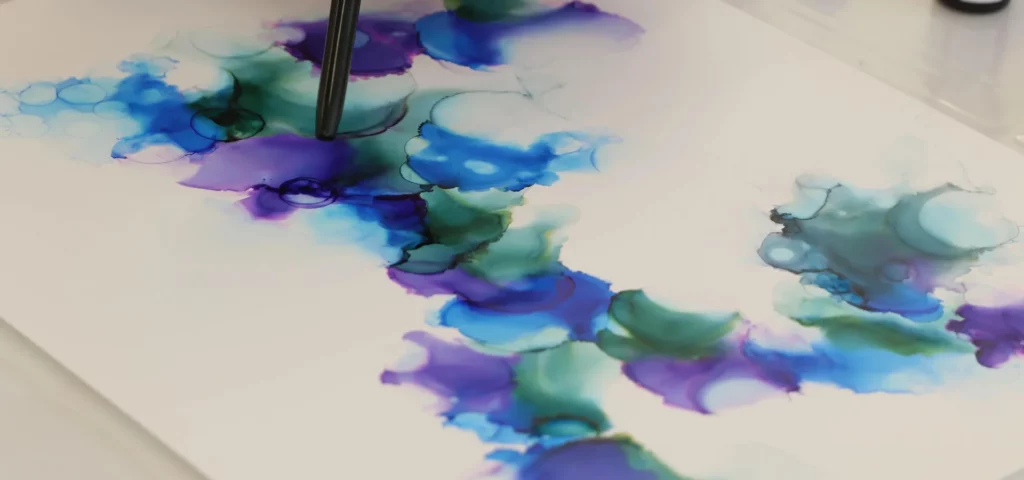
Tips for Adding Accent Colors:
- Random Splattering: Using a contrasting colour like yellow can create eye-catching effects. Simply use a brush to splatter the ink lightly, ensuring it blends seamlessly with the main colours.
- Metallic Inks: Metallic accents like gold or silver add a luxurious touch. Metallic inks are pigment-based and require thorough shaking before use. Apply them on top of blending solutions or other inks for the best result. Use a few drops and blow in one direction to create attractive clusters or lines (Piece Of My Art).
- Layering: Overlap different colours, letting them blend naturally to avoid harsh lines. This technique can create depth and interest.
Exploring accent colours can indeed take your alcohol ink artwork to the next level, ensuring each piece is unique and visually stimulating.
Applying Resin Coats for Protection
Applying a resin coat to your alcohol ink artwork not only enhances its appearance but also protects it from environmental factors. Resin coats bring out finer details, intensify colours, and provide UV protection, which is crucial since alcohol inks are prone to fading in bright conditions (ArtResin).
Benefits of Resin Coating:
- Enhanced Colours: Resin intensifies the hues of your artwork, making them pop and adding a glossy finish.
- Protection: The resin layer shields your piece from dust, moisture, and UV rays, prolonging its lifespan.
- Durability: Resin coats make your art more robust and less prone to damage.
| Attribute | Effect |
|---|---|
| Enhanced Colours | Makes hues pop and adds gloss |
| UV Protection | Prevents fading |
| Durability | Adds robustness |
Steps for Applying Resin:
- Prepare the Surface: Ensure your artwork is dry and free of any dust or debris.
- Mix the Resin: Follow the manufacturer’s instructions to mix the resin and hardener.
- Pour and Spread: Pour the mixed resin over your artwork and spread it evenly using a spatula or brush.
- Remove Bubbles: Use a heat gun or torch to eliminate air bubbles trapped in the resin.
- Cure: Allow the resin to cure as per the instructions, usually 24-48 hours, to harden and achieve a glossy finish.
Applying a resin coat is an excellent way to ensure your masterpiece remains vibrant and pristine for years to come. By incorporating accent colours and resin coating, your alcohol ink creations will not only stand out but also withstand the test of time. Dive into these methods and watch your artworks transform into dazzling, long-lasting pieces.

